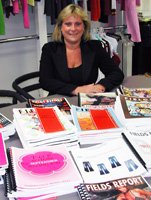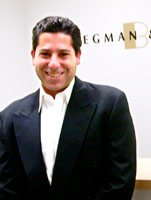L.A. Buying Offices Evolve to Adapt to a New Marketplace
As West Coast buying offices face a retail landscape littered with the remains of clients and the belt-tightening of the survivors, their mission for 2002 and beyond should be to provide added value to the traditional services afforded to their retail accounts, say industry observers. They should broaden their offerings to the entire retail macroenvironment, from servicing vendors to working with global companies.
“Their customer is no longer just the retailer,” said Ilse Metchek, executive director of the California Fashion Association. “Anyone that ships merchandise into this area through [Los Angeles International Airport] and the ports is a potential customer who needs information. They need to know what’s hot and have it in their own language, not just the slang of English. It’s hard to translate grunge or gothic into Hungarian.”
Metchek says the buying offices need to change their paradigm to avoid the fate suffered by many of their former colleagues. At one time, there were at least 15 buying offices in Los Angeles. That number has dwindled by about half, according to estimates. Most recently, the New York and Los Angeles offices of Frederick Atkins Inc. shuttered their operations, which at one time employed 350 employees and had a wholesale volume of $500 million.
One snag facing the business is the difficulty in selling department stores on new resources. Most of the major chains use a matrix system to fit the sales volume and demographics of each store location. So, buyers have to follow the listed group of vendors for the majority of their buying allocation and then use leftover funds for open-to-buy purchases.
“Buyers are so structured in these maps of how to buy, so buying offices have to be very aware of the store’s tiering profile and be able to recognize new trends for each of their regions,” said Lynne Sperling, co-owner of Sperling and Hileman Group LLC, a retail consulting firm based in San Marino, Calif.
Another way for buying offices to make a bigger stamp on the industry is to take a leadership role in teaching up-and-coming designers and manufacturers how to work with department stores. There’s a how-to gap between designers’ creative intentions and sales executions as they struggle with mastering the business side of the game.
“To do that, it’s not just about having a fashion show, but working with fashion schools and offices to help students learn how to build strong brands that resonate with the department store buyer,” Sperling said.
What hasn’t changed for most buying offices is the source of their revenues and other fees collected to pay expenses. With the exception of the Los Angeles-based Barbara Fields Buying Office, most offices not only receive monthly retainers from retailers but also charge manufacturers a fee in the hundreds of dollars to participate in shows and possible newsletters. It’s that relationship that can provide a conflict of interest, say observers.
“By not charging a fee, that frees the buying office from not making a point of view that’s not valid,” Metchek said.
In response, buying offices say there are expenses to producing events and to collateral that aren’t covered by traditional revenues.
“This is a fee to cover expenses, it’s not revenues,” said Sandy Potter, principal at Los Angeles-based Directives West.
There’s no question that buying offices lament the gritty state of the retail industry. With most merchants struggling with sales amidst a rocky economy and weakening consumer sentiment, straying from conservative purchases is typically not an option. But, it’s those reasons above all that signal a need for the market direction and strength of relationships in the market.
“It’s tougher more than ever for these retailers, so my perspective is that buying offices should be growing in importance to them,” said Cindy Sapienza, a retail consultant who was formerly a merchandiser for J.C. Penney.
Most merchants say there isn’t a better or cost-effective substitute for the information they get, even through other sources from the Internet to the media.
“[Directives West is] the eyes and ears of the California market,” said Janice Kaplan, executive vice president of Federated Merchandise Group, whose juniors and contemporary buyers visit Los Angeles three to four times a year. “L.A. is a very important fashion resource these days and it’s great to have someone who makes our lives easier.”
Another Directives West client says it’s hard to quibble with success.
“I’ve always made money with them,” said Tony Puccina, president of Milwaukee, Wis.-based Carson Pirie Scott, a division of Saks Inc. “They’re great at editing the market for a store’s individual needs. I can’t imagine people blindly shopping the showrooms. They know the principals, the designers and who’s making the product at price points you’re looking for.”
Narrowing Focus
To stay on their fashion toes, some buying offices have tried to modify their business structures.
Barbara Fields began to change with the times in 1994 when she exited most apparel categories to focus on the fast-growing juniors business. Her company ended up downsizing from 37 to about 25 employees, but the refocusing has had long-term benefits, said Fields.
“We’ve seen our sales increase 40 percent in the past few years,” she said. “And, sales alone in this first quarter have exceeded sales for the entire last year.”
Fields has built up her account base to about 100 clients, including Gadzooks, Rue 21, Wakefield’s, J.C. Penney (which is building its juniors category), Clothestime and international stores in Nicaragua and London. Fields has even signed on as a fashion director for Clothestime.
Along with increasing revenues from retailers by about 10 percent to 20 percent, to $2,500 to $10,000 a month, Fields has broadened her service approach to compensate for fees not charged to manufacturers. Instead, she has added them to her revenue model.
In the last year, she has begun to market her books to manufacturers for a flat price of $500, giving them monthly trend direction for their designing needs. Fields, a former Contempo Casuals merchandiser, mines her data on monthly trips to New York as well as half a dozen visits yearly to Paris and London. She’ll then synthesize the information into books devoted to looks ranging from the hottest European belts or scarves to the best in denim.
Fields has also taken on the role of a buyer, reducing costs for smaller stores by creating one large order for a manufacturer.
“Specialty stores might only order 60 pieces, so by putting an order together, I can give them a discount,” she said.
And, Fields has managed to earn privileges not easily given to others.
“I give her blank orders and an unlimited budget—that’s a pretty strong statement,” said Bill Wakefield, president of Wakefield’s, a six-unit chain in Anniston, Ala. “It gives us time to cultivate new vendor resources.”
Stuart Berman, president and chief executive officer of Bregman & Associates, who began the firm with his aunt, Ruth Bregman, five years ago following the closure of their employer Atkins, doesn’t deny business has gotten tougher over the years. He said retail consolidations have affected his client roster— which includes May Department Stores Co. and the U.S. military’s commissaries—by about 10 percent. The bigger issue facing retailers is the smaller number of manufacturers in Los Angeles as well.
“With the dress business cut, there are less dress manufacturers,” Berman said. “There are limits to the innovativeness and newness coming out of the market, which makes servicing retailers more difficult.”
To compensate, Bregman & Associates, whose consulting strength is in teens, young men’s, missy and accessories, has been sourcing products for retailers’ private-label ventures for the past two years, working with factories in Mexico and overseas.
“We’re eliminating the headache and travel for the retailers,” Berman said.
Another avenue of growth has been off-price opportunities. For the past three years, Berman’s firm has courted manufacturers for the first chance to move offprice goods, beating out behemoths T.J. Maxx and Marshalls.
“The manufacturers get a better price and our clients get a jump on margin builders,” Berman said.
Retail Services, Buyer Support
For other offices, the strategy is to stay the course but beef up personal service with more travel, accessibility and personal contact.
“We’re consultants to retail, we’re not manufacturers,” Directives West’s Potter said.
Widely considered the biggest buying office in terms of revenues and blue-chip clients by industry sources, Directives West began in 1982 with principal Sandy Richman, who was a former buyer and divisional director for Bullock’s. Potter joined the firm in the early ’90s after helping establish the contemporary Red Bag department at J.W. Robinson’s and serving as general merchandise manager at Broadway. The owners, along with about 25 merchandisers and staffers, focus on juniors, young men’s, girls, boys, moderate, special sizes and dresses.
Directives West provides its 40 clients, including Macy’s, Saks Fifth Avenue and Sears, Roebuck & Co., with weekly bulletins on clothing trends and monthly reports on retail activity, as well as seasonal forecasts on colors and fabrics.
Richman said a typical day can involve tackling 100 e-mails and holding conference calls but primarily involves scouting the market and shopping stores.
There’s also plenty of handholding involved in placating retailers over unreasonable expectations and reactive decision- making.
“Today I had one DMM [divisional merchandise manager] call who wanted to vacate an entire category and one buyer was upset that her business was significantly down while we’ve been saying the business was up in that category,” Potter said. Her response to the DMM was to hold firm in the category, and the response to the buyer was to say that her business wouldn’t rise as fast as others, because of the store’s early entry into the category.
The company endears itself to clients for its commitment to confidentiality, even to the point of turning away business from juniors to upscale categories. One local, growing juniors manufacturer and retailer wanted to work with Directives West, but the principals said no due to the competitive, low-cost nature of the company.
“Also, [Neiman Marcus] calls us periodically, but since we have Saks, we’ve said no to them,” Richman said.
Even for niche players, the buying office industry has gotten tougher. Off-price plus-size clothing specialist Big Deals of California, founded 15 years ago, once had an account base of 2,000 that has since dwindled to about 350 retailers, including Lots to Love, Value City Department Stores and Ross Stores. Owner Leilani Ketlinski has seen retailers such as Charade and manufacturers such as swimwear supplier Monte Carlo close their doors. As a result, her sales have declined 40 percent to about $2 million.
“We’ve seen the industry fall apart,” Ketlinski said.
One way she keeps costs down is by working as a one-person operation. Her major expense was an $80,000 customized software program installed six years ago that tracks orders, accesses shipping information and can communicate to her vendors and retailers. She also scaled back travel to the two Off- Price Specialist shows in Las Vegas. Additionally, she facilitates a lot of the transactions for her wares— which include denim, intimates, swimsuits and sweaters at 20 percent to 80 percent off wholesale prices—by telephone. Lia Caputo, We Be Bop, Lynx and Ventura Ltd. are among the vendors she sells.
In the off-price world, where shipments may not arrive from manufacturers who’ve subsequently received a bigger order from a chain, keeping clients happy means delivering on promises. It’s the integrity of her operation that helps pay the bills, according to Ketlinski.
Said Lin Anderson, owner of the More to Hug boutique in Camarillo, Calif., “As an individual store, the off-price business is dangerous territory for me, because I only buy three to four items of a style, but Leilani always calls me to see if I want a few items. She’s a straight shooter and deals with quality companies.”
























